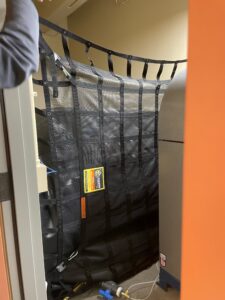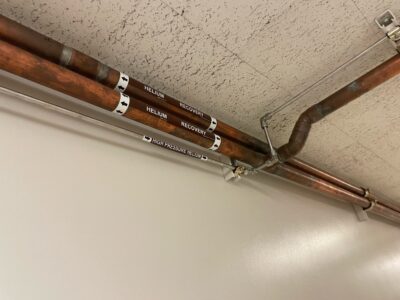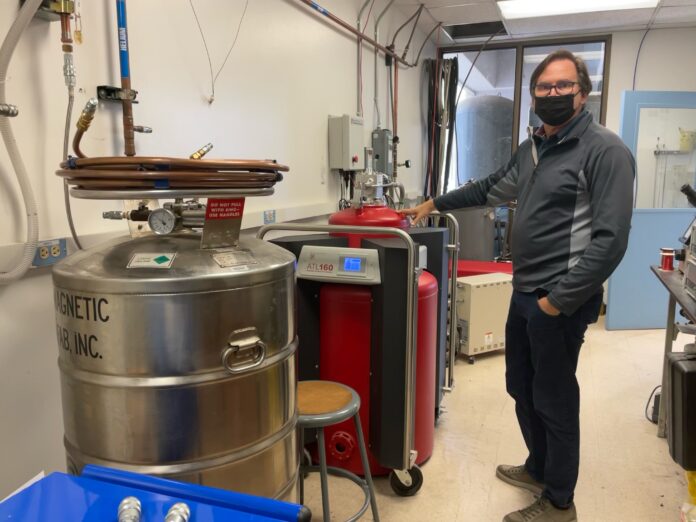Liquid helium, used to cool superconductive magnets, has faced supply shortages in recent years, and the new recovery system will allow UC Davis to have their own, reusable supply
By SONORA SLATER — science@theaggie.org
Helium is known by most for its role in filling party balloons — but with a boiling point of 4.2 K, or -452 F, liquid helium also has a unique cooling ability used in chilling magnets for superconductivity and materials science research, as well as MRI machines.
However, helium gas on Earth is a non-renewable resource created through millennia of radioactive decay, and when released to the air, it can easily escape to outer space where it is lost forever. According to Peter Klavins, a research specialist in the UC Davis Department of Physics and Astronomy, as the amount of people and machines that utilize liquid helium rises with the dawn of new technology, the supply of helium is dwindling, resulting in supply shortages and skyrocketing costs.
The UC Davis Physics Building now houses a solution to this problem: a helium recovery system, which, according to a recent press release, captures, purifies and reliquifies approximately 90% of the helium used for research. This both “advances the College’s commitment to sustainability” and cuts costs dramatically.
Klavins explained that the new helium lab was part of a renovation finished in October 2019, shortly before the pandemic.

“Helium, nowadays, is really a valuable resource,” Klavins said. “We use liquid helium to cool huge superconductive magnets, and the number of people who are using superconductive magnets has just increased over the years.”
Rahim Ullah, a graduate student in the Department of Physics at UC Davis and a member of the Taufour Lab, talked about what an essential role liquid helium — and subsequently liquid helium reuse — plays in physics research.
“The physics that we want to explore happens at low temperatures, and the easiest way to do that is to use liquid helium,” Ullah said. “That’s where you can see interesting properties, like superconductivity, and strange magnetic phenomena. Because we have helium recovery, it’s possible and affordable for us, otherwise it wouldn’t be sustainable.”
According to the press release, without helium recovery research, groups would need to pay $1,700 for liquid helium every week — now, they buy a few $200 cylinders of helium gas a month, and liquefy it themselves to make up for the small amount lost in the recovery process.
So how does it all work? Ironically, it involves what is essentially a giant helium balloon.
According to Klavins, portable helium liquefiers used directly as magnet coolers are connected to pipes running through the building. When the helium gas within boils off, it travels through the pipe to the basement, where a “compressor,” essentially a giant balloon bag, captures the gas. Once it senses pressure building, the helium gas is compressed and sent through stainless steel pipes to the purification room.

The gas, which upon entry is around 98-99% pure helium, is initially placed in a chamber to be “dried,” where any extra moisture from the air is removed. This is then purified of any residual oxygen, nitrogen or hydrogen. Finally, it is reliquified to be sent back up for use, leaving at 99.9995% pure helium.
“Industrial liquifiers have been around forever, but they’re huge and require a lot of training to be able to operate,” Klavins said. “What’s nice about these portable units is that they were really designed for academic research use, so if it needs to be used by a postdoc student, a graduate student, it’s manageable.”
As far as what it’s used for, Klavins explained that while liquid helium and superconductive magnets have many uses, one of the main ones at UC Davis is studying the physical properties of new materials.
Valentin Taufour, an associate professor in the Department of Physics and Astronomy at UC Davis and group leader of the Taufour Lab, elaborated on the intersection between materials science and superconductive magnets.
“Materials is actually the biggest branch of physics nowadays, because there are many properties that we’re not able to explain with our current laws of physics,” Taufour said. “So we study, at a very low temperature, how they react to changes in a magnetic field. We study their fundamental properties. It’s sort of a booming field of research right now.”
According to Ullah, who studies magnetic phenomena, the goal of understanding underlying theory and properties is equally applicable to magnetism — once there is better understanding, engineers can work toward application. According to Taufour, one big thing industry magnets are currently being used in that is likely to expand in the future is the manufacture of green technologies, such as electric motors.
Klavins explained that another benefit of the helium reuse system is a hiring advantage for the university — there’s certain types of research that can only be sustainably done in a facility where helium liquidation and reuse is possible.
“We’re not limited as much by the supply, like some other campuses are,” Klavins said. “If the supply is down, their research might suffer, but we’re able to keep going because we essentially have our own supply. And without this, we couldn’t have a large condensed matter program.”
Taufour expanded on the same idea.
“In the past, people have done experiments and just wasted helium,” Taufour said. “That is no longer an option. If we didn’t have the liquifier, we couldn’t do what we do. If we didn’t have this facility, there’s a whole category of research, where if someone tried to come here to do it, they’d just have to go somewhere else.”
According to the press release, financial support for the new Helium Lab comes from faculty research funding and a $10,000 gift from Klavins and his spouse, Distinguished Professor of Chemistry Susan Kauzlarich, along with gifts received through the department’s Liquid Helium Laboratory Fund.
Written by: Sonora Slater — science@theaggie.org





